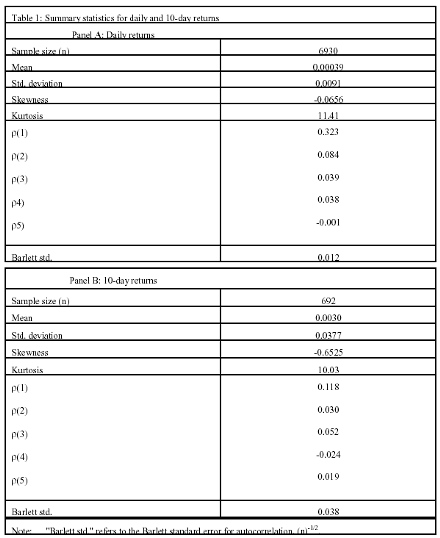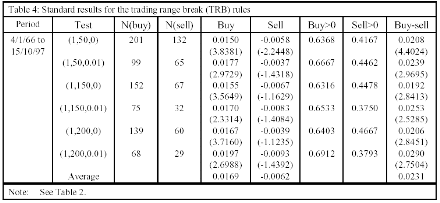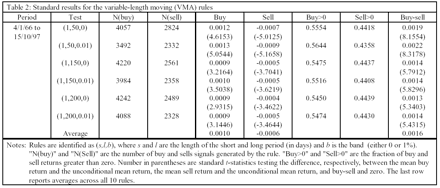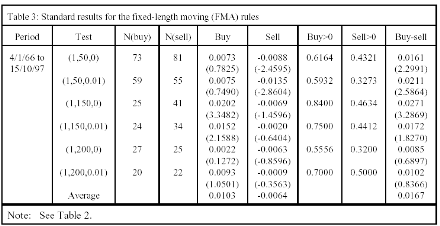Panel A and B in Table 1 reports some summary statistics for daily and 10- day returns series, respectively. Returns are calculated as daily changes in logarithms of the IGBM level, and thus exclude dividends yields. As can be seen, these returns exhibit excessive kurtosis and (marginal) negative skewness, indicating nonnormality in returns. On the other hand, the first order serial correlation coefficient is significant and positive. Autocorelations at a higher lag are considerably closer to zero.

If technical analysis does not have any power to forecast price movements, then we should observe that returns on days when the rules emit by signals do not differ appreciably from returns on days when the rules emit sell signals. To evaluate the forecast power of technical trading rules, we compute mean return and variance on buy and sell days for each rule described.
In Table 2 we present the results from VMA trading strategies. As mentioned above, we examine ten rules (s,l,b), differing by the length of the short and long period (s and l, respectively, in days) and by the of size the band (b: 0 or 1%). In particular, in Table 2 we report the number of buy and sell signals generated during the period ["N(Buy)" and "N(Sell)", respectively], the mean buy and sell returns ("Buy" and "Sell", respectively), the fraction of buy and sell returns greater than zero ("Buy>0" and "Sell>0") and the difference between the mean daily buy and sell returns ("Buy-Sell"). The t-statistics for the "Buy" ("Sell") statistics are computed using the following formulae (see BLL, 1992, footnote 9):

where µr and Nr are the mean return and the number of signals for the buys and sells, and m and N are the unconditional mean and the number of observations. σ2 is the estimated variance for the entire sample. For the "Buy-Sell", the t-statistic is

where µb and Nb are the mean return and number of signals for the buys, and µs and Ns are the mean return and the number of signals for the sells.
As can be seen in Table 2, the buy-sell differences are significantly positive for all rules. The introduction of the one percent band increases the spread between the buy and sell returns. The number of buy signals generated by each rule always exceeds the number of sell signals, by between 44 and 76 percent, which is consistent with an upward-trending market.
The mean buy returns are all positive with an average daily return of 0.10 percent, which is about 28.4 percent at an annual rate2. All t-statistics reject the null hypothesis that the returns equal the unconditional returns (0.039 percent from Table 1). For the sells, all means returns are negative, with an average daily return of -0.06 percent, or -16.2 on an annualized basis, and all but one of the t-statistics are significantly different from zero.
Regarding "Buy>0" and "Sell>0" statistics, the buy fraction is consistently greater than 50 percent, while that for all sells is considerably less, being in the region of 43.6 to 44.4 percent. Under the hypothesis that technical trading rules do not produce useful signals, these fractions should be the same: a binomial test shows that these differences are highly significant and the null of equality can be rejected.
These results are strikingly similar to those reported by BLL (1992, Table II)3, who emphasised the difficulty in explaining them with an equilibrium model that predicts negative returns over such a fraction of trading days.
Results for the FMA trading rule are presented in Table 3 in the same format as Table 2. We examine fixed 10-day holding periods after a crossing of the two moving averages. As can be seen in Table 3, the buy-sell difference is positive for all the tests. Nevertheless, only in 3 of the 10 tests the null hypothesis that the difference is equal to zero can be rejected. As before, the addition of a one percent band increases the buy-sell difference, except for those rules with long-period moving average equal to 150 days.
The buy returns are again all positive with an average daily return of 1.03 percent during the 10-day period following the signal4. None of the t-statistics reject the null hypothesis that the returns equal the unconditional 10-day return (0.30 percent from Table 1). For the sells, all means returns are negative, with an average daily return of -0.64 percent, but only 2 of the 10 t-statistics are significantly different from zero. For all the individual rules examined, the fraction of buys greater than zero exceeds the fraction of sells greater than zero.
Table 4 presents the results for the TRB rule. As shown in that table, the buysell difference is always positive and in all cases the null hypothesis that the difference is equal to zero can be rejected. The buy returns are again all positive with an average daily return of 1.7 percent. The t-statistics suggest that the buy returns are significantly different from the unconditional 10-day return. Regarding the sells, the returns are always negative, being only 1 of the 6 t-statistics are significant. The fraction of buys greater than zero exceeds the fraction of sells greater than zero.

Given that the period covered is very long and heterogeneous, with a number of important events that could affect the structure of the series, we have also considered two nonoverlapping subperiods, being 19 October 1987 the breaking point, including in the second period the effects of the "crash" of 1987 and the readjustments of 1989 and 1991, as well as the change in the clearing and settlement procedures and the inception of the IBEX35 futures market. The results (not present here, but available from the authors upon request) are similar to those reported for the complete sample and, therefore, we found no evidence that the results are different across subperiods.
Note:
2. Throughout this paper, we compute approximate annualized returns on the basis of 250 trading days per year as exp(250r)-1, where r is the mean daily return.
3. Note that, while in BLL (1992) the buy returns from VMA rules yield an average return of 12 percent at an annual rate for the Dow Jones Index from 1897 to 1986, using the same VMA rules we obtain a return of 28.4 percent at an annual rate.
4. This is approximately twice the average daily return found by BLL (1992) for the Dow Jones Index from 1897 to 1986.
By F. Fernández, S. Sosvilla and J. Andrada
Next: Bootstrap results
Summary: Index

